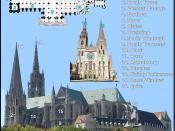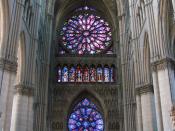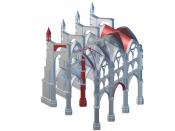For nearly four hundred years Gothic style dominated the architecture of Western Europe.
It originated in northern France in the twelfth century, and spread rapidly across England and the
Continent, invading the old Viking empire of Scandinavia. It confronted the Byzantine provinces
of Central Europe and even made appearances in the near East and the Americas. Gothic
architects designed town halls, royal palaces, courthouses, and hospitals. They fortified cities and
castles to defend lands against invasion. But it was in the service of the church, the most prolific
builder of the Middle Ages, that the Gothic style got its most meaningful expression, providing the
widest scope for the development of architectural ideas.1
Although by 1400 Gothic had become the universal style of building in the Western world,
its creative heartland was in northern France in an area stretching from the royal domain around
Paris, including Saint-Denis and Chartres, to the region of the Champagne in the east and
southward to Bourges.
Within this restricted area, in the series of cathedrals built in the course of
the 12th and 13th centuries, the major innovations of Gothic architecture took place.2
The supernatural character of medieval religious architecture was given a special form in
the Gothic church. 'Medieval man considered himself but an imperfect refraction of Divine Light
of God, Whose Temple stood on earth, according to the text of the dedication ritual, stood for the
Heavenly City of Jerusalem.'3 The Gothic interpretation of this point of view was a cathedral so
grand that seems to belittle the man who enters it, for space, light, structure and the plastic effects
of the stonework are made to produce a visionary scale. The result of the Gothic style is
distortion as there is no fixed set of proportions in the parts. Such architecture did...


